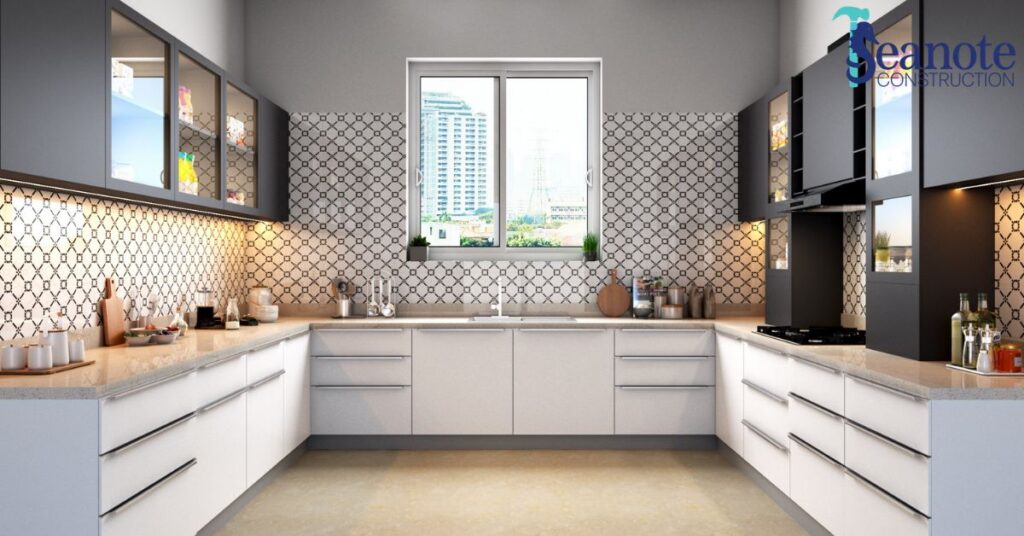Kitchen cabinets offer functionality and add to the aesthetic of your kitchen, often making up a significant part of your remodel budget. One common material used for cabinets is particleboard. Before making a decision, it’s important to weigh the pros and cons of particleboard cabinets to determine if they’re the right choice for your kitchen.
According to Global Market Insights, the particleboard market was valued at USD 25.4 billion in 2023 and is estimated to grow over 5.5% from 2024 to 2032, showcasing the growing demand for this material.
At Seanote Construction, we understand the importance of getting it right the first time. With a reputation for honesty and clear communication, we’re here to guide you through the pros and cons of particleboard cabinets. Choosing the right material for your kitchen cabinets is no small task, especially when balancing budget and durability.
Key Takeaways
- Particleboard is a budget-friendly wood product made from compressed wood scraps and resin, commonly used in cabinets.
- It is an affordable, eco-friendly, lightweight, customizable material, and is ideal for laminates or veneers.
- However, it can be less durable, prone to moisture damage, difficult to repair, and has limited weight capacity.
- Professionals recommend particleboard for affordable projects but caution against its durability in demanding settings.
What is Particleboard?
Particleboard is a type of engineered wood made by compressing wood chips, sawdust, and resin into a dense, flat panel. Unlike solid wood, which is cut directly from trees, particleboard is created from leftover wood materials, making it an eco-friendly option.
This material is often used for kitchen cabinets and shelving because it’s lightweight and easy to work with. However, it’s not as strong as plywood or MDF (Medium-Density Fiberboard), which are other common types of engineered wood. Particleboard is usually covered with laminates or veneers to improve its appearance and durability.
Pros of Particleboard Cabinets
Here are some key benefits of using particleboard cabinets:
- Affordable: Particleboard is one of the most budget-friendly materials for kitchen cabinets, making it a great choice for cost-conscious homeowners.
- Smooth Surface: Its even surface is perfect for laminates or veneers, giving cabinets a sleek, polished look.
- Eco-Friendly: Made from recycled wood products, particleboard helps reduce waste and promotes sustainable practices.
- Lightweight: Particleboard is easy to handle and install, which can simplify the renovation process.
- Customizable: Available in a variety of sizes and finishes, it works well in many different kitchen designs.
Cons of Particleboard Cabinets
Here are the most common concerns with particleboard cabinets:
- Less Durable: Particleboard isn’t as strong as plywood or solid wood and can break down faster with heavy use.
- Moisture Issues: It swells and weakens when exposed to water, making it unsuitable for humid or wet environments.
- Difficult to Repair: Once chipped or damaged, particleboard is hard to fix and may need replacement.
- Limited Weight Capacity: It doesn’t handle heavy loads well, so it’s not ideal for supporting stone countertops or storing heavy items.
- Unfinished Appearance: Without a laminate or veneer, the raw surface looks unattractive and unpolished.
Particleboard vs. Other Cabinet Materials
When choosing cabinets, it’s important to compare particleboard with other popular materials to see how they differ and to know which option is best for you.

Particleboard vs. All-Wood Cabinets
- Cost: Particleboard is significantly cheaper than solid wood, which makes it ideal for budget-conscious projects.
- Durability: All-wood cabinets last longer and are less prone to damage, making them better for high-traffic kitchens.
- Aesthetic Appeal: Solid wood offers a natural, high-end look, while particleboard relies on laminates or veneers for style.
Particleboard vs. Plywood
- Moisture Resistance: Plywood is more water-resistant than particleboard, making it a better choice for humid environments.
- Strength: Plywood is stronger and handles heavy use better, but it comes at a higher cost.
- Workability: Particleboard’s smooth surface makes it easier to coat, while plywood’s layered structure can make finishing more challenging.
Particleboard vs. MDF
- Density: MDF is denser and more durable than particleboard, which makes it better for intricate designs and heavy use.
- Cost: MDF is more expensive than particleboard but still affordable compared to plywood or solid wood.
- Finish: Both materials work well with laminates and veneers, but MDF has a smoother surface for painting.
Tips for Maintaining Particleboard Cabinets
Follow these tips to maintain the appearance and durability of your particleboard cabinets:
- Protect Against Moisture: Use water-resistant laminates or edge-banding to seal exposed areas and prevent swelling.
- Avoid Overloading: Don’t store heavy items in particleboard cabinets to reduce stress on the material.
- Clean Gently: Wipe with a soft, damp cloth and mild cleaner to avoid scratching or damaging the surface.
- Repair Quickly: If edges chip or peel, reseal or apply touch-up materials as soon as possible to prevent further damage.
- Use Cabinet Liners: Place liners inside to protect against spills, stains, and wear.
Your Trusted Partner for Durable and Affordable Cabinetry
At Seanote Construction, we go above and beyond to deliver cabinetry solutions that fit your budget and lifestyle. If you’re considering particleboard or exploring other materials, we’re here to provide genuine advice and top-quality craftsmanship.
Contact us today to get started on your dream kitchen—because with Seanote, you’re not just hiring a contractor; you’re gaining a partner for life.

